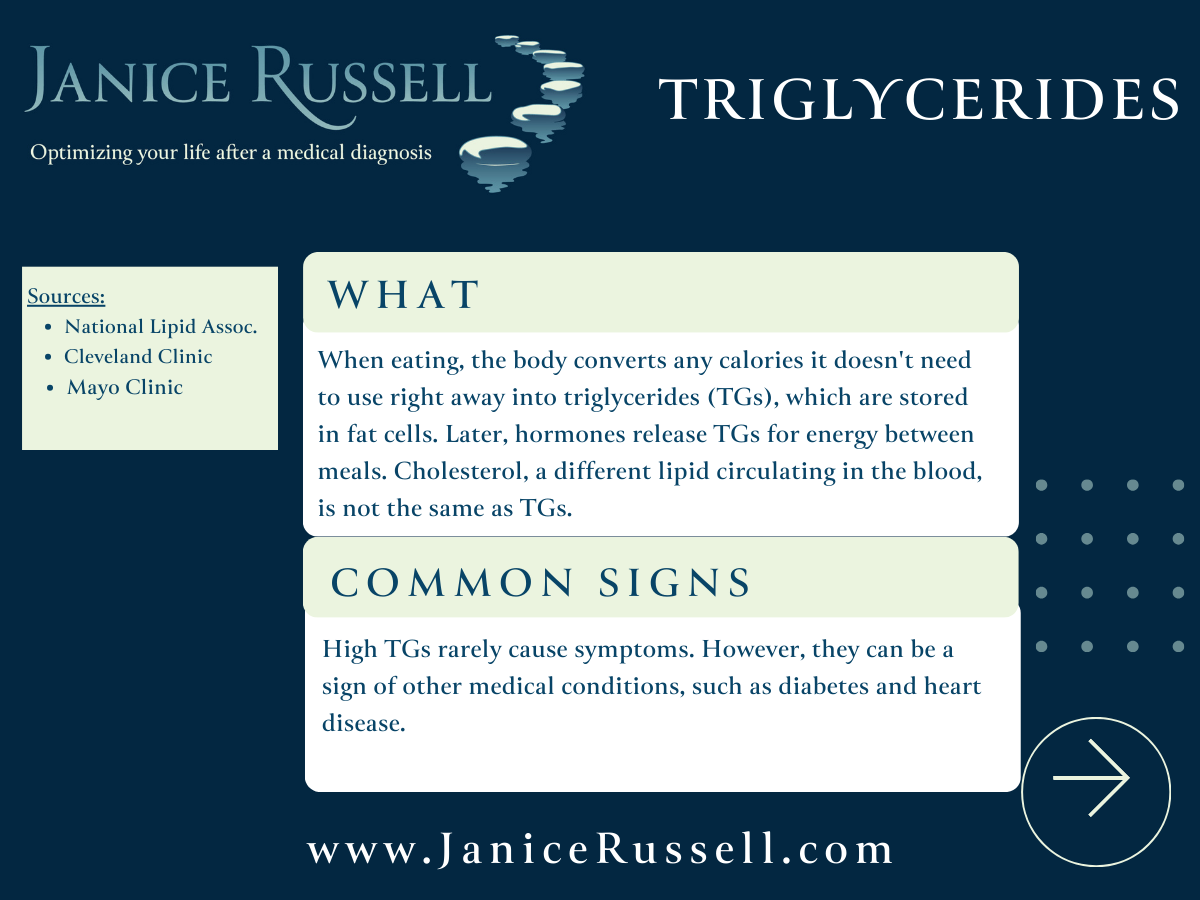
Triglycerides 101: Essential Facts You Need to Know
It’s hard to understand how someone who regularly exercises and eats healthy has cholesterol numbers that are high. It’s not me, it’s my mom.
So out of curiosity, I researched the basics about triglycerides (TGs) so I could be more knowledgeable, both for her and me. I want to share this information with you as well. So here goes:
Triglycerides are a type of fat (lipid) found in our blood, playing a vital role in the body’s energy metabolism and overall health. While they are crucial to numerous biological processes, excessive levels can increase the risk of cardiovascular diseases and other health conditions.
WHAT ARE TRIGLYCERIDES?
They are the most common form of fat in the human body and serve as a significant energy source. When we consume food, our bodies convert excess calories it doesn’t need immediately into TGs. These molecules are stored in fat cells and released later as energy between meals.
Triglycerides are transported through the bloodstream in lipoproteins, which are particles made of fat and protein.
NORMAL vs. HIGH TRIGLYCERIDE LEVELS
Measuring triglycerides is part of a standard blood test called a lipid panel. For the most accurate reading, you should fast eight to 12 hours before this test.
Levels are categorized as follows:
- Normal: Less than 150 milligrams per deciliter (mg/dL)
- Borderline high: 150–199 mg/dL
- High: 200–499 mg/dL
- Very high: 500 mg/dL or more
High triglyceride levels can result from various factors, including excessive calorie intake, obesity, sedentary lifestyle, poorly managed diabetes, excessive alcohol consumption, and certain genetic conditions.
WHY DO TRIGLYCERIDES MATTER?
Maintaining healthy TG levels is crucial for cardiovascular health. Elevated triglycerides are associated with several risks:
- Heart Disease and Stroke: High triglyceride levels contribute to the development of atherosclerosis—a condition in which fatty deposits build up on the walls of arteries, narrowing them, and increasing the risk of heart attack and stroke.
- Pancreatitis: Extremely high TG levels can lead to inflammation of the pancreas, causing severe abdominal pain and other complications.
- Metabolic Syndrome: High triglycerides are a component of metabolic syndrome, which includes a cluster of conditions like high blood pressure, high blood sugar, and abdominal fat, increasing the risk of heart disease and diabetes.
FACTORS INFLUENCING TRIGLYCERIDE LEVELS
Several lifestyle and genetic factors can influence TG levels:
- Diet: Consuming high amounts of sugars, refined carbohydrates, and fats often leads to elevated levels. Excess calories—regardless of their source—can be converted into triglycerides.
- Activity Level: Physical inactivity is a key contributor to higher TG levels.
- Health Conditions: Obesity, Type 2 diabetes, and hypothyroidism can raise triglycerides.
- Alcohol: Excessive alcohol consumption can spike triglyceride levels because alcohol is rich in sugars.
- Genetics: Some people inherit conditions, such as familial hypertriglyceridemia, that predispose them to elevated TGs.
HOW TO MANAGE & LOWER TRIGLYCERIDE LEVELS
Taking proactive steps can effectively lower TG levels and improve overall health:
- Adopt a Healthy Diet:
- Reduce the intake of sugary and processed foods.
- Choose unsaturated fats found in foods like avocados, nuts, seeds, and olive oil over saturated fats.
- Incorporate omega-3 fatty acids, found in fatty fish like salmon, mackerel, and sardines.
- Exercise Regularly: Aim for at least 150 minutes of moderate-intensity aerobic exercise per week, such as brisk walking, cycling, or swimming.
- Maintain a Healthy Weight: Losing even a small percentage of body weight can lead to significant reductions in TG levels.
- Limit Alcohol Consumption: If you drink, do so in moderation or avoid alcohol altogether, especially if your levels are already high.
- Manage Underlying Conditions: Work with your healthcare provider to address conditions like diabetes or hypothyroidism that may contribute to elevated levels.
- Medications: In cases of very high TGs, medications such as fibrates, omega-3 fatty acid supplements, or statins may be prescribed.
- Eastern Medicine Approaches: For those who prefer holistic and natural methods, here are some options:
- Herbal Remedies: Traditional Chinese Medicine (TCM) often uses specific herbs which may help improve lipid metabolism and reduce TG levels.
- Acupuncture: This practice is believed to balance the body’s energy (Qi) and may support overall cardiovascular health, indirectly aiding in triglyceride management.
- Dietary Adjustments: Eastern dietary principles emphasize whole, unprocessed foods. Incorporating foods rich in omega-3 fatty acids, green tea, and fiber can help lower TGs.
- Ayurveda: This Indian traditional medicine system recommends certain herbs along with lifestyle changes, to manage triglycerides.
- Mind-Body Practices: Yoga, Tai Chi, and meditation are integral to Eastern medicine and can reduce stress, which is a contributing factor to high TGs.
THE BIGGER PICTURE
While triglycerides often take a backseat to cholesterol in discussions about health, they are equally important. As such, addressing and managing TG levels can significantly enhance long-term well-being.
Bottomline: triglycerides are a natural and necessary part of our biology, but they require careful attention. By understanding their role and taking proactive steps to maintain healthy levels, we can protect our heart and lead a healthier life. The journey toward better health starts with awareness and actionable habits—small changes today can yield big results for the future.
For me, getting the blood test is the easy part. Given family history, I know it’s prudent for me to increase my exercise and eat healthier food. I guess it’s time for Client Janice to have a conversation with Coach Janice so I can make changes in my schedule to accommodate more movement and cooking time!
If you have high TG levels or another diagnosis that requires lifestyle modifications, which tiny change would make the most impact?
Type your “tiny change” in the comments below. It will make you more likely to take action!
Resources for this article:

